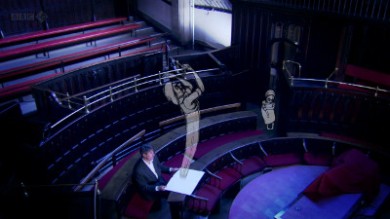Today I saw a documentary about a creepy seventeenth century English witch trial in which a 9-year-old beggar girl testified against her mother, sister and brother, condemning them to execution. The girl’s name was Jennet Device*.
The documentary by BBC Four is hosted by Simon Armitage, who tells the story with interjections from various historical experts and with the aid of very spooky, pale, spectral, sketchy animations of important scenes by Phoebe Boswell. For me, it is these which make the telling of the story so chilling, and definitely worth watching.
This is the story of Jennet Device, as I remember it.
Four hundred years ago a poor rural family lived together in their stone home called Malkin Towers; a grandmother, mother, a son and two daughters. The mother’s husband had died some years before and the youngest daughter, Jennet, was illegitimate. The grandmother, Elizabeth Southerns (known as “Old Demdike”), was a “cunning woman”, a woman with gifts in naturopathy and healing (different from a witch, who turns such gifts to curses and evil). One day Jennet’s sister, Alizon, begged a travelling peddler for some pins, but he ignored her. She cursed him and was terrified when soon after he fell prone, displaying symptoms of what we now would call a stroke. Alizon was overcome with guilt and remorse and went to his bedside to beg for forgiveness. However the peddler’s son accused her of witchcraft.
In 1612 James the First was the king of England. Intensely Protestant, he not only denounced Catholics and witches but was paranoid that both were out to get him. (As documentary host Armitage noted, being paranoid doesn’t necessarily mean you’re wrong. Case in point: Guy Fawkes’ Catholic plot to blow up the king and parliament). King James published his own book called Daemonologie instructing that witches and users of witchcraft must be prosecuted and punished. In 1612 he ordered every JP (Justice of the Peace; magistrate) in Lancashire to record the name of every person who didn’t attend communion. Roger Nowell was the JP for Pendle, and an over-zealous butt-kisser who sought the approval of the king. It was to Nowell that the peddlar’s son made his accusation of Alizon’s witchcraft and she and her mother and brother were summoned to court. Ultimately it was Old Demdike, the grandmother, and three neighbours who were sent to gaol to be tried for witchcraft.
 That year on Good Friday, the mother (also Elizabeth) held a meeting at Malkin Towers, a gathering for which son James stole a sheep to be roasted. Roger Nowell heard about the meeting and as a result of his investigation eight more people were sent to be tried for witchcraft, including Elizabeth and James Device.
That year on Good Friday, the mother (also Elizabeth) held a meeting at Malkin Towers, a gathering for which son James stole a sheep to be roasted. Roger Nowell heard about the meeting and as a result of his investigation eight more people were sent to be tried for witchcraft, including Elizabeth and James Device.
It is interesting to realise that many of those accused of witchcraft believed themselves that they were witches. Many, like Old Demdike, had been openly practicing home remedies and charms for many years, sometimes for payment, while some like Alizon were wretched and distraught with guilt. Others accused, though, like the more well-to-do Alice Nutter (from a prominent Catholic family, two of whom had been executed for being Catholic priests), had nothing to do with witchcraft and were probably “in the wrong place at the wrong time”.
Note that in our story there has been no mention, yet, of Jennet Device.
But now we come to it.
Four months later the trial at the Lancaster Assizes took place in Lancaster Castle, a prison then and right up until 2010. The prosecution’s star witness was young Jennet Device, about nine years old. Although children that young weren’t usually allowed to appear as witnesses in court, King James wrote in his Daemonologie that children were acceptable witnesses in cases of treason or witchcraft. When she was brought into the court her mother went mad yelling and screaming at her (probably trying to make her understand what she was doing), and Jennet asked that she be removed.
In one of the spookiest scenes in the documentary, the small girl then got up on a table and gave evidence against her mother and sister. She told the court her mother was a witch and had brown dog named Ball as a familiar, who her spirit entered and who helped her commit murders. Her brother James also testified against his mother saying he’d seen her making clay figures, but Jennet said she had also seen his spirit moving about and had seen him conjure a black dog, his familiar called Dandy, and tell him to kill a man. Jennet Device also identified those who attended the gathering at Malkin Tower. In a very creepy scene in the documentary the spectre of the small girl walks along lineups of people produced by the court and picks out each one who was at Malkin Tower.
Of the ten found guilty, nine were held in a tiny cell with other inmates at Lancaster Gaol, where Old Demdike had already passed away. They were hanged on nearby Gallows Hill, probably with Jennet Device in attendance. Today the hill is a park and children’s playground.
Jennet Device’s testimony had wide and far-reaching consequences as her case became a precedent for using children as witnesses in cases of witchcraft, particularly through a book called Dalton’s Country Justice. This book was used by British magistrates as a handbook for applying the law in the UK and in the New World, and was used in the Salem witch trials eighty years after the Pendel witch trials; it cited the case of Jennet Device as precedent for seeking children as witnesses in cases of witchcraft.
So what happened to Jennet Device? Why did she do what she did? Was she resentful, as the bastard child, of the rest of her family and wanted revenge? Was she intimidated and afraid of the court and the judges and magistrates? Had she been schooled, in the months before the trial by Nowell? How did she live with herself afterwards and as she grew up?
Well. In a spectacular case of “tasting your own medicine”, twenty years later Jennet Device was caught up in another witch trial, this time with the star witness/accuser as a young boy, made possible by the precedent she herself set years earlier.
The young Edmund Robinson returned home late one evening. His excuse? (Phoebe Boswell’s illustrations of this are really great:) He had been picking berries when he saw two dogs sleeping. He tried to get them to chase a hare by hitting them with a stick, but they turned into a witch and a boy, and then the witch turned the boy into a horse and took Edmund away to a house full of witches, where ropes hung from the ceiling and when the witches pulled on them, wonderful food fell down. Edmund was afraid, so he escaped but on the way home he ran into a boy with cloven hoofs and they fought, which is why he was so scruffy when he got home.
Not only did people believe this story, but the boy’s father took him from village to village for three months identifying the witches he had seen. He would go into a church and stand on a stool or table and gaze into the congregation, picking out those who were witches.
One of those he selected was named Jennet Device.
Edmund had chosen twenty women, nineteen of whom were found guilty. However the times had changed and King James’ son, Charles the First, was more credulous of accusations of witchcraft. The matter was referred to the privy counsel in London, where the public could view four of the women in the gaol for a penny, and see a theatrical performance of The Witches of Lancashire, a play of Edmund’s story. The “devil’s mark” (where the devil had suckled) in the women’s “secrets” was examined by the king’s physician and they were found not guilty. Edmund admitting lying, basing his story on stories he’d heard of the Device family. His father had been blackmailing women, if they didn’t pay him he would tell Edmund to accuse them of witchcraft.
Despite their acquittal, the women remained in the Lancaster Gaol and probably died there.
* (her surname is pronounced “Dev-iss”).






